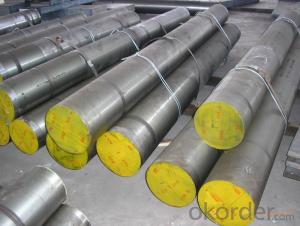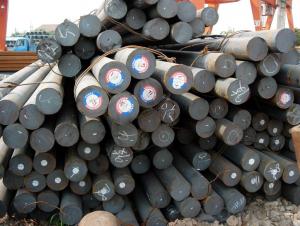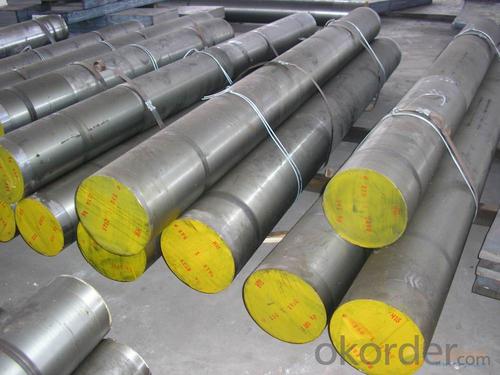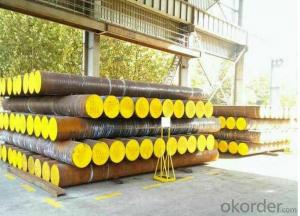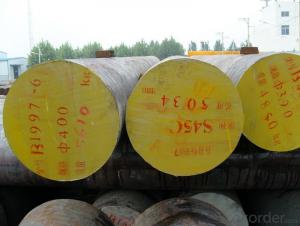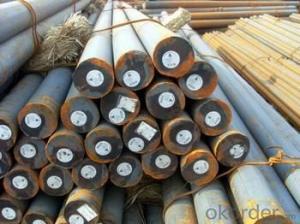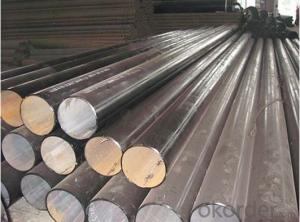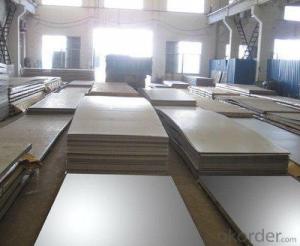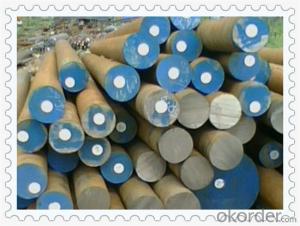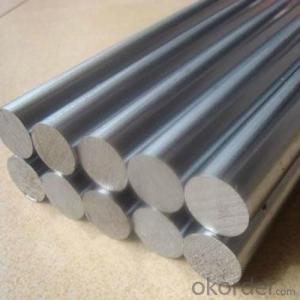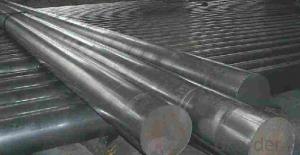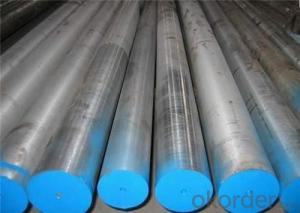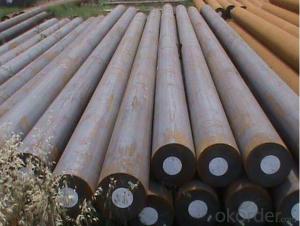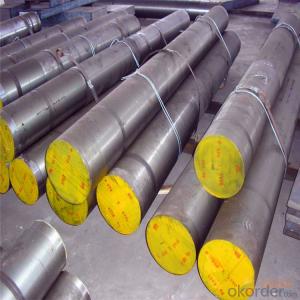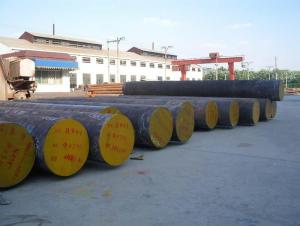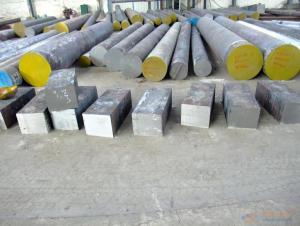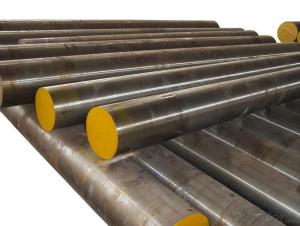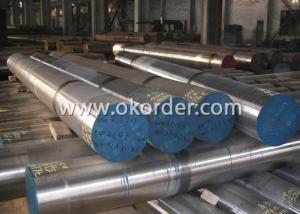SAE 52100 Bearing Steel Round Bars
- Loading Port:
- Tianjin
- Payment Terms:
- TT OR LC
- Min Order Qty:
- 25 m.t.
- Supply Capability:
- 50000 m.t./month
OKorder Service Pledge
OKorder Financial Service
You Might Also Like
Specification
SAE 52100 Bearing Steel Round Bars
Product description:
Material | suj2 | ||
Chemical Composition | Mechanical Properties(In Quenched & Tempered State) | ||
C | 0.95-1.05 | Tensile strength(MPA) | ---- |
Si | 0.15-0.35 | Yield strength (MPA) | -- |
Mn | 0.25-0.45 | Elongation(δ5/%) | -- |
Cr | 1.40-1.65 | Reduction in Area (ψ/%) | -- |
Mo | ≤0.10 | Impact (J) | -- |
P | ≤0.025 |
Hardness | HB170-207 HB207-229 HB270-390 HB229-285 HRC62-66 HRC61-66 HRC≈67 |
S | ≤0.025 | ||
Ni | ≤0.30 | ||
Cu | ≤0.25 | ||
Ni+Cu | ≤0.50 | ||
Charactteristics:
Flat Steel GCr15 Flats are of
Good hardening ability. Good wear resistance. Shadow depth of hardness
Harden from a temperature of 790-820oC, 820-860oC followed by water or oil quenching. Hardness after quenching is 63-67, 63-66 HRC.
Tempering temperature: 150-300oC. Hardness after tempering is 56-65 HRC.
Application:
Commom steel used to produce balls and rings of bearing. The product has characteristics of uniform-chemical composition, low percentage of harmful elements, high purity, well-distributed carbide, good surface quality. It also has characteristics of wide scope of plastic,stable heat-treatment quality, uniformand high hardness, high wear resistance,high strength of touching fatigue. It has excellent machining property afer spheroidize annealing.
The use of products The product is used to produce balls and rings of bearing. Future Development By rational rolling and cooling process, the product can be spheroidized on-line and can be used in drawing and machining directly by customers. By combining re-spheroidize annealing and re-crystallisation of semi-finished product, the steel wire process can be simplified.
Product show:
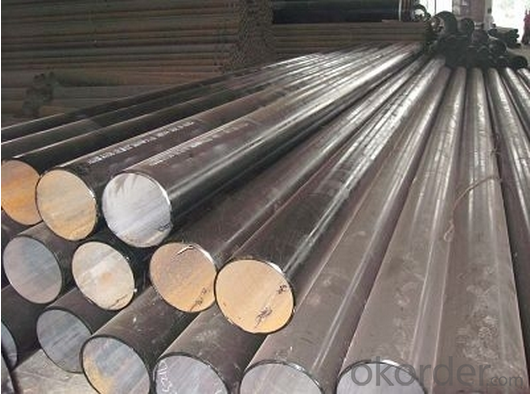
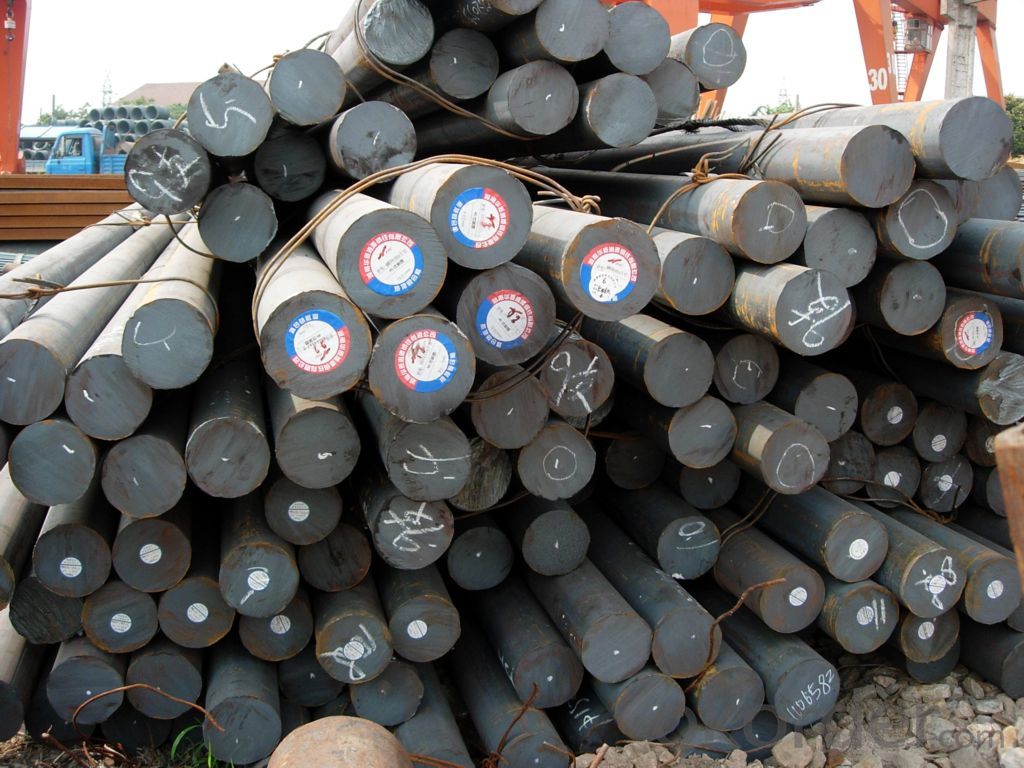
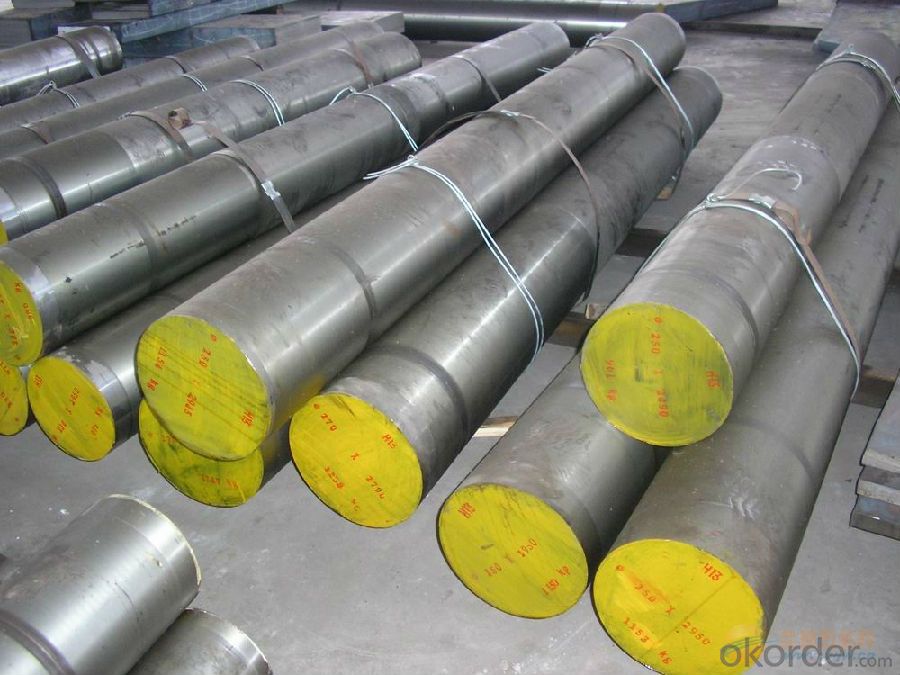
- Q: What is the hardness range of special steel?
- The hardness range of special steel can vary depending on the specific type and composition, but it typically falls within the range of 50 to 65 HRC (Rockwell Hardness Scale).
- Q: How does special steel contribute to the creep resistance of products?
- Special steel contributes to the creep resistance of products through its unique properties and composition. Creep is the gradual deformation of a material under constant stress over time, and it is a critical concern in industries that require high temperatures and prolonged usage. Special steel, also known as high-temperature steel or heat-resistant steel, is specifically designed to withstand these extreme conditions and minimize creep. One of the key factors contributing to the creep resistance of special steel is its high melting point. Special steel is typically alloyed with elements such as chromium, nickel, molybdenum, and vanadium, which significantly increase its melting point compared to ordinary steel. This enhanced heat resistance allows special steel to maintain its structural integrity and resist deformation even at elevated temperatures. Moreover, the unique microstructure of special steel plays a crucial role in its creep resistance. Special steel is engineered to have a fine-grained structure, which improves its strength and prevents the movement of dislocations within the material. Dislocations are defects in the atomic arrangement of a material that can lead to creep deformation. By minimizing the movement of dislocations, special steel exhibits higher resistance to creep and maintains its shape and dimensional stability over extended periods. In addition to its microstructure, special steel often has a higher content of certain alloying elements. For instance, the addition of elements like molybdenum and vanadium enhances the creep strength of special steel by forming stable carbides within the material. These carbides act as barriers to dislocation movement, further impeding creep deformation and improving the overall creep resistance of the product. Furthermore, special steel is often subjected to advanced heat treatment processes, such as quenching and tempering, to optimize its mechanical properties and enhance its creep resistance. These heat treatments help to refine the microstructure, improve the distribution of alloying elements, and increase the hardness and strength of the material, all of which contribute to better resistance against creep. Overall, special steel's ability to withstand high temperatures, its unique microstructure, and its alloying elements and heat treatment processes combine to provide exceptional creep resistance. This makes special steel an ideal choice for various applications that require durability and longevity under extreme thermal conditions, such as gas turbines, nuclear reactors, high-temperature boilers, and aerospace components.
- Q: What is the chemical composition of special steel?
- Special steel encompasses a wide range of steel alloys that possess specific properties and characteristics. The chemical makeup of special steel can differ depending on the particular grade or type of steel being discussed. Nevertheless, special steel typically contains greater amounts of alloying elements compared to regular carbon steel. These alloying elements may consist of chromium, nickel, molybdenum, vanadium, tungsten, and others. The specific combination and proportion of these alloying elements determine the distinctive properties of special steel, such as increased strength, enhanced resistance to corrosion, improved ability to withstand high temperatures, or better resistance to wear and tear. To illustrate, some common variations of special steel include stainless steel, which generally consists of high levels of chromium and nickel, resulting in excellent corrosion resistance; tool steel, which contains high carbon content and often includes additional elements like vanadium or tungsten, making it suitable for cutting, drilling, or shaping tools; and high-speed steel, which incorporates elements such as molybdenum, cobalt, or tungsten, providing exceptional hardness and heat resistance, ideal for use in cutting tools or drills. To summarize, the chemical composition of special steel varies based on the specific type or grade, but it typically involves elevated levels of alloying elements to achieve desired properties such as strength, corrosion resistance, heat resistance, or wear resistance.
- Q: What are the different types of free-cutting steel?
- The different types of free-cutting steel include leaded free-cutting steel, sulfurized free-cutting steel, and resulfurized and rephosphorized free-cutting steel.
- Q: How does special steel comply with international standards?
- Special steel complies with international standards through a rigorous quality control process that involves testing the material for its chemical composition, mechanical properties, and dimensional accuracy. These standards, such as ISO, ASTM, and DIN, ensure that the steel meets the required specifications and performance criteria for various applications. Manufacturers also follow strict production guidelines and undergo regular audits to maintain compliance with these international standards.
- Q: What are the challenges in machining special steel with high hardness?
- One of the major challenges in machining special steel with high hardness is the excessive tool wear. High hardness steel tends to be abrasive and causes rapid tool degradation, leading to frequent tool changes and increased production costs. Additionally, the high hardness makes it difficult to achieve precise cuts and maintain tight tolerances, affecting the overall quality of the machined parts. Another challenge is the generation of high cutting forces, which can strain the machine and potentially cause vibrations or distortions in the workpiece. Therefore, machining special steel with high hardness requires specialized tooling, advanced cutting strategies, and careful monitoring to overcome these challenges and achieve satisfactory results.
- Q: How does special steel contribute to the manufacturing of automotive engine components?
- Special steel plays a crucial role in the manufacturing of automotive engine components as it offers exceptional strength, durability, and heat resistance properties. It allows for the production of lighter and more fuel-efficient engines without compromising on performance. Special steel also ensures reliable and efficient functioning of engine parts, such as pistons, crankshafts, valves, and connecting rods, resulting in improved overall engine performance and longevity.
- Q: How does special steel contribute to the automotive suspension industry?
- Enhanced strength, durability, and performance are essential qualities that special steel brings to the automotive suspension industry. Suspension components greatly benefit from special steel alloys, particularly high-strength low-alloy (HSLA) steel, which are tailor-made to withstand the demanding conditions of the suspension system. This ensures optimal performance and safety. One of the primary advantages of special steel in the automotive suspension industry lies in its outstanding strength-to-weight ratio. Suspension components crafted from special steel alloys can endure heavy loads without succumbing to deformation, resulting in improved vehicle handling, stability, and overall performance. Its strength also contributes to increased durability, reducing the likelihood of premature component failure and extending the lifespan of the suspension system. Moreover, special steel offers superb fatigue resistance, a critical characteristic in the suspension industry where components experience repeated stress and vibrations. This fatigue resistance prevents the occurrence of cracks and fractures in suspension parts, guaranteeing dependable and secure operation even in challenging conditions. Additionally, special steel alloys provide superior corrosion resistance, safeguarding suspension components from the damaging effects of moisture, salt, and other environmental factors. This corrosion resistance extends the lifespan of the suspension system, decreasing maintenance costs, and enhancing overall reliability. Furthermore, special steel allows for improved design flexibility in suspension components. Its unique properties, such as high formability and weldability, enable manufacturers to create intricate and lightweight designs, resulting in more efficient suspension systems. These lightweight designs not only contribute to fuel efficiency and reduced emissions but also enhance the overall driving experience by improving vehicle agility and responsiveness. In summary, special steel plays an indispensable role in the automotive suspension industry, delivering enhanced strength, durability, and performance to suspension components. Its exceptional strength-to-weight ratio, fatigue resistance, corrosion resistance, and design flexibility contribute to improved handling, stability, safety, and overall vehicle performance. Through its unique properties, special steel ensures reliable and efficient suspension systems, satisfying the demanding requirements of the automotive industry.
- Q: What are the different methods of surface laser cladding for special steel?
- There are several methods of surface laser cladding for special steel, including powder-based laser cladding, wire-based laser cladding, and direct laser cladding. Powder-based laser cladding involves melting a powder material onto the surface of the steel using a laser beam. Wire-based laser cladding uses a wire feed system to deliver the material to be cladded onto the surface, which is then melted by the laser. Direct laser cladding directly melts the material onto the steel surface without the need for additional feed systems, making it a more efficient and precise method.
- Q: What are the potential health hazards associated with working with special steel?
- There are potential health risks when working with special steel due to the materials and processes involved. Some of the main health hazards associated with this work include: 1. Inhaling harmful fumes: Special steels often contain various alloys and elements, such as chromium, nickel, and manganese. These can release toxic fumes when heated or welded. Prolonged exposure to these fumes can cause respiratory issues like bronchitis, asthma, or even lung cancer. 2. Irritation of the skin and eyes: Steelworking involves handling sharp edges, cutting tools, and abrasive materials, which can cause cuts, scratches, or puncture wounds. If not treated properly, these injuries can become infected or lead to more serious conditions. Additionally, contact with certain alloys in special steel can irritate the skin or cause allergic reactions. It's important to wear eye protection to prevent injuries from debris or sparks. 3. Hearing loss caused by noise: Steel manufacturing processes often involve heavy machinery, which creates high levels of noise. Prolonged exposure to this noise can result in permanent hearing loss or other auditory issues. Using appropriate hearing protection, like earmuffs or earplugs, can help reduce the risk. 4. Hazards related to ergonomics: Steelworking often requires repetitive movements, heavy lifting, or uncomfortable postures. This can lead to musculoskeletal disorders such as back pain, carpal tunnel syndrome, or tendonitis. Employers should implement proper ergonomic practices, such as adjustable workstations, lifting aids, and regular breaks, to prevent these hazards. 5. Thermal hazards: Special steel manufacturing processes involve high temperatures, such as welding or forging. Without proper protective clothing or equipment, this can result in burns. Exposure to extreme heat can also lead to heat-related illnesses like heat exhaustion or heat stroke. Adequate training, appropriate personal protective equipment (PPE), and regular breaks in cooler areas can help reduce these risks. To protect workers from these potential health hazards, employers should follow proper safety protocols. This includes providing employee training, ensuring the use of personal protective equipment, conducting regular health monitoring, and maintaining a clean and well-ventilated work environment. It is important to strictly adhere to occupational health and safety regulations in order to minimize the risks involved in working with special steel.
Send your message to us
SAE 52100 Bearing Steel Round Bars
- Loading Port:
- Tianjin
- Payment Terms:
- TT OR LC
- Min Order Qty:
- 25 m.t.
- Supply Capability:
- 50000 m.t./month
OKorder Service Pledge
OKorder Financial Service
Similar products
Hot products
Hot Searches
Related keywords
